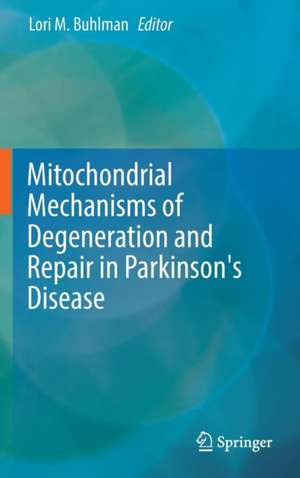Mitochondrial Mechanisms of Degeneration and Repair in Parkinson's Disease
Editat de Lori M. Buhlmanen Limba Engleză Hardback – 23 sep 2016
| Toate formatele și edițiile | Preț | Express |
|---|---|---|
| Paperback (1) | 1107.56 lei 6-8 săpt. | |
| Springer International Publishing – 27 iun 2018 | 1107.56 lei 6-8 săpt. | |
| Hardback (1) | 1113.58 lei 6-8 săpt. | |
| Springer International Publishing – 23 sep 2016 | 1113.58 lei 6-8 săpt. |
Preț: 1113.58 lei
Preț vechi: 1358.02 lei
-18% Nou
Puncte Express: 1670
Preț estimativ în valută:
213.11€ • 231.41$ • 179.01£
213.11€ • 231.41$ • 179.01£
Carte tipărită la comandă
Livrare economică 23 aprilie-07 mai
Preluare comenzi: 021 569.72.76
Specificații
ISBN-13: 9783319421377
ISBN-10: 3319421379
Pagini: 234
Ilustrații: XII, 275 p. 28 illus., 23 illus. in color.
Dimensiuni: 155 x 235 x 18 mm
Greutate: 0.58 kg
Ediția:1st ed. 2016
Editura: Springer International Publishing
Colecția Springer
Locul publicării:Cham, Switzerland
ISBN-10: 3319421379
Pagini: 234
Ilustrații: XII, 275 p. 28 illus., 23 illus. in color.
Dimensiuni: 155 x 235 x 18 mm
Greutate: 0.58 kg
Ediția:1st ed. 2016
Editura: Springer International Publishing
Colecția Springer
Locul publicării:Cham, Switzerland
Cuprins
Mitochondrial ROS and Apoptosis.- Dopamine Metabolism and Reactive Oxygen Species Production.- The Consequences of Damaged Mitochondrial DNA.- The role of chronic inflammation in the etiology of Parkinson’s disease.- Ion-Catalyzed Reactive Oxygen Species in Sporadic Models of Parkinson's Disease.- Toxin Mediated Complex I Inhibition and Parkinson’s Disease.- Parkinson Disease-Associated Mutations Affect Mitochondrial Function.- PARKIN/PINK1 Pathway for the Selective Isolation and Degradation of Impaired Mitochondria.- Mitochondrial Therapeutic approaches in Parkinson's Disease.- Altering Mitochondrial Fusion and Fission Protein Levels Rescues Parkin and PINK1 Loss-of-Function Phenotypes.- Early Nicotine Exposure is Protective in Familial and Idiopathic Models of Parkinson’s Disease.- Transcription Modulation of Mitochondrial Function and Related Pathways as a Therapeutic Opportunity in Parkinson’s Disease.- Delivery of Biologically Active Molecules to Mitochondria.
Notă biografică
Lori Buhlman earned her Ph.D. in Neuroscience from the University of Arizona and trained as a post-doctoral fellow at the Institut National de la Santé et de la Recherche Médicale, in Paris, France. She is currently an associate professor of Biomedical Sciences and Behavioral Medicine at Midwestern University in Glendale, Arizona, where she manages a research program exploring the mechanisms by which loss of Parkin function causes neurodegeneration. Her recent publications report that nicotine can protect against motor deficits caused by Parkin loss of function in Drosophila, and that Parkin and PINK1 work together to promote mitochondrial homeostasis in a manner that involves mitochondrial fission protein, Drp1.
Textul de pe ultima copertă
This volume brings together various theories of how aberrations in mitochondrial function and morphology contribute to neurodegeneration in idiopathic and familial forms of Parkinson’s disease. Moreover, it comprehensively reviews the current search for therapies, and proposes how molecules are involved in specific functions as attractive therapeutic targets. It is expected to facilitate critical thought and discussion about the fundamental aspects of neurodegeneration in Parkinson’s disease and foster the development of therapeutic strategies among researchers and graduate students. Theories of idiopathic Parkinson’s etiology support roles for chronic inflammation and exposure to heavy metals or pesticides. Interestingly, as this project proposes, a case can be made that abnormalities in mitochondrial morphology and function are at the core of each of these theories. In fact, the most common approach to the generation of animal and cell-culture models of idiopathic Parkinson’s diseaseinvolves exposure to mitochondrial toxins. Even more compelling is the fact that most familial patients harbor genetic mutations that cause disruptions in normal mitochondrial morphology and function. While there remains to be no effective treatment for Parkinson’s disease, efforts to postpone, prevent and “cure” onset mitochondrial aberrations and neurodegeneration associated with Parkinson’s disease in various models are encouraging. While only about ten percent of Parkinson’s patients inherit disease-causing mutations, discovering common mechanisms by which familial forms of Parkinson’s disease manifest will likely shed light on the pathophysiology of the more common idiopathic form and provide insight to the general process of neurodegeneration, thus revealing therapeutic targets that will become more and more accessible as technology improves.
Caracteristici
Summarizes theories of how poor mitochondrial function and morphology contribute to neurodegeneration Discusses both sporadic and familial forms of Parkinson's disease Proposes potential molecules that would make attractive therapeutic targets Includes supplementary material: sn.pub/extras













